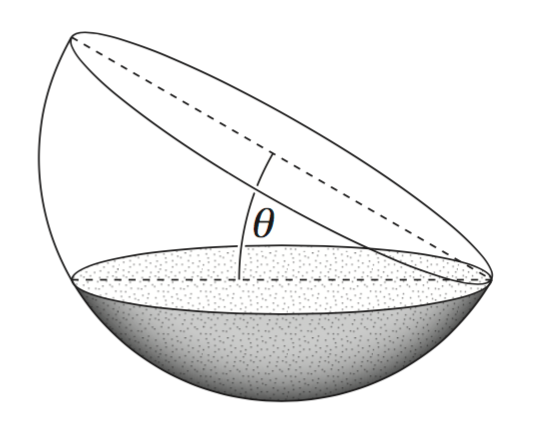The region, \(R\), is bounded by the function, \(y=x^3\), the \(x\)-axis and the lines \(x=1\) and \(x=2\). What is the volume of the solid of revolution obtained when the region \(R\) is rotated about the \(x\)-axis? (3 marks) --- 6 WORK AREA LINES (style=lined) ---
Calculus, EXT1 C3 2022 SPEC1 10
Let `f(x)=\sec (4 x)`.
- Sketch the graph of `f` for `x \in\left[-\frac{\pi}{4}, \frac{\pi}{4}\right]` on the set of axes below. Label any asymptotes with their equations and label any turning points and the endpoints with their coordinates. (3 marks)
- The graph of `y=f(x)` for `x \in\left[-\frac{\pi}{24}, \frac{\pi}{48}\right]` is rotated about the `x`-axis to form a solid of revolution.
Find the volume of this solid. Give your answer in the form `\frac{(a-\sqrt{b}) \pi}{c}`, where `a`, `b`, `c in R`. (3 marks)
Calculus, EXT1 C3 2022 HSC 13b
A solid of revolution is to be found by rotating the region bounded by the `x`-axis and the curve `y=(k+1) \sin (k x)`, where `k>0`, between `x=0` and `x=\frac{\pi}{2 k}` about the `x`-axis.
Find the value of `k` for which the volume is `pi^2`. (3 marks)
--- 8 WORK AREA LINES (style=lined) ---
Calculus, EXT1 C3 2021 SPEC1 4
The shaded region in the diagram below is bounded by the graph of `y = sin(x)` and the `x`-axis between the first two non-negative `x`-intercepts of the curve, that is interval `[0, pi]`. The shaded region is rotated about the `x`-axis to form a solid of revolution.
Find the volume, `V_s` of the solid formed. (3 marks)
Calculus, EXT1 C3 2020 HSC 13b
Calculus, EXT1 C3 SM-Bank 3
Find the volume of the solid of revolution formed when the graph of `y = sqrt((1 + 2x)/(1 + x^2))` is rotated about the `x`-axis over the interval `[0,1]`. (3 marks)
Calculus, EXT1* C3 2019 HSC 13d
Calculus, EXT1 C3 SM-Bank 1
The region enclosed by the semicircle `y = sqrt(1 - x^2)` and the `x`-axis is to be divided into two pieces by the line `x = h`, when `0 <= h <1`.
The two pieces are rotated about the `x`-axis to form solids of revolution. The value of `h` is chosen so that the volumes of the solids are in the ratio `2 : 1`.
Show that `h` satisfies the equation `3h^3 - 9h + 2 = 0`. (3 marks)
--- 8 WORK AREA LINES (style=lined) ---
Calculus, EXT1* C3 2017 HSC 12b
Calculus, EXT1* C3 2016 HSC 15a
The diagram shows two curves `C_1` and `C_2.` The curve `C_1` is the semicircle `x^2 + y^2 = 4, \ -2 <= x <= 0.` The curve `C_2` has equation `x^2/9 + y^2/4 = 1, \ 0 <= x <= 3.`
An egg is modelled by rotating the curves about the `x`-axis to form a solid of revolution.
Find the exact value of the volume of the solid of revolution. (4 marks)
--- 10 WORK AREA LINES (style=lined) ---
Calculus, EXT1* C3 2004 HSC 4c
Calculus, EXT1* C3 2007 HSC 3a
Find the volume of the solid of revolution formed when the region bounded by the curve `y = 1/(sqrt(9 + x^2))`, the `x`-axis, the `y`-axis and the line `x = 3`, is rotated about the `x`-axis. (3 marks)
--- 6 WORK AREA LINES (style=lined) ---
Calculus, EXT1 C3 2005 HSC 5a
Find the exact value of the volume of the solid of revolution formed when the region bounded by the curve `y = sin 2x`, the `x`-axis and the line `x = pi/8` is rotated about the `x`-axis. (3 marks)
--- 8 WORK AREA LINES (style=lined) ---
Calculus, EXT1* C3 2007 HSC 9a
Calculus, EXT1* C3 2008 HSC 6c
The graph of `y = 5/(x - 2)` is shown below.
The shaded region in the diagram is bounded by the curve `y = 5/(x - 2)`, the `x`-axis and the lines `x = 3` and `x = 6`.
Find the volume of the solid of revolution formed when the shaded region is rotated about the `x`-axis. (3 marks)
--- 6 WORK AREA LINES (style=lined) ---
Calculus, EXT1 C3 2014 HSC 12b
Calculus, EXT1* C3 2014 HSC 14c
Calculus, EXT1 C3 2013 HSC 12b
Calculus, EXT1* C3 2009 HSC 6a
Calculus, EXT1* C3 2010 HSC 10b
The circle `x^2 + y^2 = r^2` has radius `r` and centre `O`. The circle meets the positive `x`-axis at `B`. The point `A` is on the interval `OB`. A vertical line through `A` meets the circle at `P`. Let `theta = /_OPA`.
- The shaded region bounded by the arc `PB` and the intervals `AB` and `AP` is rotated about the `x`-axis. Show that the volume, `V`, formed is given by
- `V = (pi r^3)/3 (2-3 sin theta + sin^3 theta)` (3 marks)
--- 8 WORK AREA LINES (style=lined) ---
- A container is in the shape of a hemisphere of radius `r` metres. The container is initially horizontal and full of water. The container is then tilted at an angle of `theta` to the horizontal so that some water spills out.

- (1) Find `theta` so that the depth of water remaining is one half of the original depth. (1 mark)
--- 4 WORK AREA LINES (style=lined) ---
- (2) What fraction of the original volume is left in the container? (2 marks)
--- 6 WORK AREA LINES (style=lined) ---









